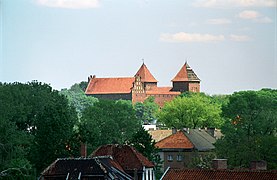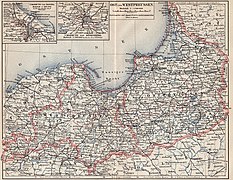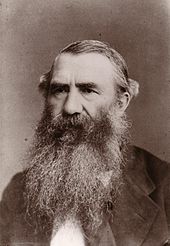Nidzica
| Nidzica | ||
|---|---|---|

|
|
|
| Basic data | ||
| State : | Poland | |
| Voivodeship : | Warmia-Masuria | |
| Powiat : | Nidzica | |
| Gmina : | Nidzica | |
| Area : | 6.86 km² | |
| Geographic location : | 53 ° 21 ' N , 20 ° 26' E | |
| Residents : | 13,762 (June 30, 2019) | |
| Postal code : | 13-100 | |
| Telephone code : | (+48) 89 | |
| License plate : | NNI | |
| Economy and Transport | ||
| Street : | E 77 Warsaw - Gdansk | |
| Rail route : | Działdowo – Olsztyn | |
| Next international airport : | Warsaw | |
Nidzica [ ɲiˈʥiʦa ] (formerly also in Polish Nibork , Nidbork ; German Neidenburg ) is a town in the powiat Nidzicki of the Warmian-Masurian Voivodeship in Poland . It is the seat of the town-and-country municipality of the same name with 21,045 inhabitants (as of June 30, 2019).
Geographical location
The city is located in the historical region of East Prussia , in the southern part of the East Prussian Oberland and on the southern edge of the Allenstein Lake District, about 50 kilometers south of Allenstein ( Olsztyn ) and 140 kilometers south of Königsberg ( Kaliningrad ).
The Nida (Neide) flows through the city , which today as in the past gave the place its name. The surrounding area is characterized by the hilly landscape of the Oberland, Neidenburg itself is at an altitude of 172 meters. Large pine forests stretch to the northeast. The city is the intersection of several highways, the European route 77 connects it with Allenstein. There is a railway connection there.
history
A wild man is drawn on the city arms . If unconfirmed sources are true that there was an order castle called "Neidenburg" as early as 1266, this would be one of the first in Sassenland, which was uninhabited jungle area in the 13th century and was only settled by the Teutonic Order at the beginning of the 14th century . The exact time when Neidenburg was founded is also unknown, but it is believed to be around 1360. As in general in Sassen, the settlement was mainly carried out by the second generation of colonists who immigrated from Central Germany in the 13th century. Craftsmen and merchants settled at the Neidenburg, which the order had renovated in the middle of the 14th century with a stone building. On December 7th, 1381 the Grand Master of the Order Winrich von Kniprode granted the settlement town charter and gave it 40 Hufen tax-free land. 10 Hufen received Neidenburg's first mayor , the ironworks operator Hans Grans. The city was subordinated to the Osterode Commandery for administrative purposes.
Since Neidenburg was near the border to the Polish-ruled Mazovia , it was the target of Polish-Lithuanian attacks on several occasions. The Lithuanian prince Gediminas attacked the city for the first time in 1331 , but failed, as did his sons Algirdas and Kęstutis later . A peace treaty in 1397 created security for a few years, but Neidenburg was captured and plundered by Polish troops as early as 1410 during the war between the Teutonic Order and Poland. The same thing happened in 1414 after a long siege. During the Thirteen Years' War between the Teutonic Order and the Prussian Federation (1454–1466), which defended itself against financial exploitation , Neidenburg joined the rebels, but had to accept an occupation by Polish troops who supported the Bund. Only with the conclusion of the Second Peace of Thorne did the Poles withdraw again. In the last campaign of the order against Poland, the equestrian war from 1519 to 1526, the Polish army tried to conquer the city, but had to break off the siege after seven weeks without result. In recognition of the steadfastness of the citizens, Grand Master Albrecht waived the basic interest for twenty years. Because of its strategic importance as a border town with Poland, the castle was expanded into a modern fortress after the war. The Reformation was introduced in Neidenburg as early as 1524 for the religious state .
After the monastic state had been secularized and converted into the Duchy of Prussia in 1525 , Neidenburg was incorporated into the Oberland District and became the seat of a main office. The evangelical country became a center of attraction for religious refugees from all over Europe, in Neidenburg in 1549 the Bohemian Brothers settled. In 1573 a Latin school and in 1579 the first girls' school was founded in southern Prussia. When Tatars invaded the southern parts of the country in the course of the Second Northern War in 1656 , Neidenburg had to endure another siege, which was again unsuccessful. In contrast, in 1664 a large city fire caused considerable damage. The plague that raged in the country between 1709 and 1711 also killed half of the population in Neidenburg. After an administrative reform in 1752 Neidenburg became the center of the newly created Neidenburg district . After the city had already been elevated to a garrison town in 1717 , it now gained considerably in importance through the establishment of the district office, tax and judicial authorities. The population rose to 1,554 by 1782. During the Seven Years' War Neidenburg was occupied by Russian troops from 1758 to 1760, without the city suffering any significant damage. However, the 19th century began with further setbacks. First, in 1804, another town fire destroyed the church, school and several houses.
Distant view of the Ordensburg
Neidenburg south of Allenstein on a map from 1908
When East Prussia was occupied by Napoleon's troops in 1806, the French also moved into Neidenburg, and the city had to bear the costs of billeting, which amounted to 179,426 thalers during the two-year occupation. The city had to go into debt for this, and it took an entire generation to repay it. In the middle of the 19th century a positive development started again. As early as 1830, the castle was by order of King Friedrich Wilhelm III. has been completely renovated, and the demolition of the city wall around 1850 and the drainage of moor areas created space for the town to expand. The district court moved into the restored castle, and the prison was relocated there. The construction of the Osterode – Soldau road and the Allenstein – Soldau railway line opened in 1887/1888 created the basis for industrial settlements. At the end of the 19th century, a machine factory, a copper goods factory and several steam mills were located in Neidenburg. In 1890 the city had 4,221 inhabitants, of which 83 percent were Protestant and 13 percent were Catholic. There were also 154 Jews.
Already at the beginning of the First World War , Neidenburg was badly affected. On August 22nd, 1914, a Cossack troop occupied the city, plundered and started a fire, which destroyed the church and over 200 other houses. After the Tannenberg Battle (August 27-29, 1914) won by Germany , Neidenburg was recaptured and reconstruction was immediately initiated with the help of the sponsored city of Cologne . Bodo Ebhardt created the planning for this, but his neo-Gothic designs were not implemented, rather the reconstruction was carried out in the classical style. The town hall was built based on Eberhardt's designs, but with a completely modified facade.
After the end of the war, the residents, together with the whole Neidenburg district, were called upon to decide between belonging to East Prussia or Poland by means of a referendum in the Allenstein area . On July 11, 1920, 3,156 residents voted to remain in East Prussia and 17 to join Poland. Since the border to the newly created so-called Polish Corridor only passed Neidenburg a few kilometers, the city was now completely on the edge of East Prussia, with negative effects on the economic situation. However, the number of inhabitants rose sharply due to the influx of resettlers from the West Prussian territories lost to Poland. In 1925, around 6,500 people lived in the city. This number increased to 9,197 by 1939. During the “ Reichspogromnacht ” on November 9, 1938, the synagogue was destroyed and two Jewish residents were murdered. Instead of the synagogue, the city built the "Grenzlandmuseum".
Although the first Soviet troops penetrated the district on January 18, 1945 towards the end of the Second World War , an evacuation order for the population was only issued during the defensive battles. The hurriedly assembled refugee routes were quickly overrun by the Red Army and ended in chaos. The city of Neidenburg was captured by Soviet soldiers on January 19th. After the end of the war, Neidenburg and the southern half of East Prussia were placed under Polish administration. Then the immigration of Polish civilians began. In phonetic alignment with the Polish language, Neidenburg was initially renamed "Nidbork", later the city was given the official name "Nidzica". Where German locals had not fled, they were in the period that followed largely driven .
The city became the seat of a powiat , which on August 25, 1945 counted 23,478 inhabitants (15,954 Polish new settlers and 7,514 Germans who stayed behind, of which the Polish authorities assigned 5,903 inhabitants to the Masurian people , the so-called autochthons ).
Population development until 1945
| year | Residents | Remarks |
|---|---|---|
| 1782 | 1,700 | |
| 1802 | 1,728 | |
| 1810 | 1,645 | |
| 1816 | 1,836 | including 1,683 Evangelicals, 126 Catholics and 27 Jews |
| 1821 | 2,241 | |
| 1831 | 2,347 | partly German, partly Polish |
| 1867 | 2,853 | 300 Catholics and 200 Jews, 730 Poles |
| 1875 | 4,259 | |
| 1880 | 4,351 | |
| 1890 | 4.221 | 3,506 Protestants, 561 Catholics and 154 Jews |
| 1933 | 8,396 | |
| 1939 | 9,197 |
Attractions
The Neidenburg , an order castle built in the 14th century , was rebuilt after its destruction in the Battle of East Prussia . She watched over the border with Polish Mazovia. The castle was the seat of a subordinate order official, a so-called carer , who resided on the main floor of the west wing, where there is still a chapel. The magnificent east facade of the castle with two protruding square towers is remarkable. The castle houses the town and regional museum, a gallery, a sculptor's workshop, a library, a hotel and a restaurant.
In the old town , next to the parish church and the town hall, hardly any historical buildings have been preserved; but the city complex with the large market square is still recognizable. The bell of the former Protestant, now Catholic parish church has been hanging in the tower of the Silvanus Church in Berenbostel near Hanover since 1998 .
The Roman Catholic Church of the Conception of Mary and St. Adalbert (Protestant church until 1948) was built in the 14th century in the Gothic style.
The Protestant Holy Cross Church (Catholic church until 1948) was built from 1858 to 1860 in neo-Gothic style; the tower dates from 1890.
In the south of the city is the Tatar stone , a boulder , the ball of which is placed in memory of the siege of the city in 1656.
Sponsored city
Bochum has been the sponsored city of the Neidenburg district community , an association of the expelled German population from the city and district of Neidenburg , since 1953 .
local community
The town itself and 34 villages with school offices belong to the town-and-country municipality (gmina miejsko-wiejska) Nidzica.
traffic
The Nidzica long-distance train station is located on the Działdowo – Olsztyn railway line and was the start of the Nidzica – Wielbark railway line .
sons and daughters of the town
- Stephan von Neidenburg , * around 1412, bishop of Kulm
- Daniel Hermann (* around 1543–1601), humanist and poet
- Orlando Gortzitza , born November 9, 1811, teacher and hymn poet
- Ferdinand Gregorovius , born January 19, 1821, German writer and historian
- Bethel Henry Strousberg , born November 20, 1823, German entrepreneur from the early days
- Richard Guenter , born July 4, 1856, businessman, MdR
- Georg Albrecht Klebs , born October 23, 1857, German botanist
- Heinrich Lissauer , born September 12, 1861, German neurologist
- Walter Kollo , born January 28, 1878, German composer
- Eugen Mossakowsky , born November 1, 1898, German national revolutionary and editor
- Georg Basner , born June 18, 1905, German teacher, playwright and theater maker
- Wilhelm Grezesch , born May 1, 1906, German politician (NSDAP)
- Annemarie Ladewig * June 5, 1919, German graphic artist, resistance fighter and victim of National Socialism
- Jürgen Nicolai , born October 24, 1925, German ornithologist, author and behavioral scientist
- Heinz Lilienthal, born April 25, 1927, German glass painter and design artist
- Rita Kuczynski * February 25, 1944, German writer, philosopher and publicist
- Heinz Koriath * February 22, 1952, German legal scholar
- Józef Roszynski SVD * August 18, 1962, Polish religious, bishop in Papua New Guinea.
literature
- Johann Friedrich Goldbeck : Complete topography of the Kingdom of Prussia . Part I: Topography of East Prussia . Königsberg / Leipzig 1785, p. 27, no. 2).
- Schimmelpfennig: Notes from the older and more recent times of the city of Neidenburg . In: Contributions to the customer of Prussia , Volume 4, Königsberg 1821, pp. 228-240.
- August Eduard Preuss : Prussian country and folklore or description of Prussia. A manual for primary school teachers in the province of Prussia, as well as for all friends of the fatherland . Bornträger Brothers, Königsberg 1835, pp. 459–461, no. 74.
- Max Meyhöfer : The Neidenburg district: an East Prussian homeland book . Bochum, 1968
Web links
- Official website of the city
- GenWiki: Neidenburg district (with map of the district)
- Photos and founding history of Neidenburg / Nidzica and other cities of the former Order
- Neidenburg district community
Individual evidence
- ↑ Johannes Voigt : History of Prussia from the oldest times to the fall of the rule of the Teutonic Order . Volume 5: The time from Grand Master Ludolf König von Weizau in 1342 to the death of Grand Master Konrad von Wallenrod . Königsberg 1832, pp. 258-259.
- ↑ Jan Salm: "East Prussian Cities in World War I - Reconstruction and Reinvention", Oldenbourg Wissenschaftsverlag , 2012, ISBN 978-3-486-71209-4 , pp. 154 ff
- ^ Herbert Marzian ; Csaba Kenez : Self-determination for East Germany. Documentation on the 50th anniversary of the East and West Prussian referendum on July 11, 1920. Göttinger Arbeitskreis , 1970, p. 91
- ↑ Alexander Solzhenitsyn described his experiences as an officer in East Prussian Nights and as a story in Schwenkitten '45 with, among other things, “Whoever is still a virgin becomes a woman / and women - corpses soon.” Lew Kopelew describes his experiences when the Red Army marched into Neidenburg in his autobiography keep forever!
- ^ Johann Friedrich Goldbeck : Complete topography of the Kingdom of Prussia . Volume 2: Topography of West Prussia , Marienwerder 1789, p.27, no.2).
- ↑ a b c d Alexander August Mützell and Leopold Krug : New topographical-statistical-geographical dictionary of the Prussian state . Volume 5: T – Z , Halle 1823, pp. 338–339, item 473.
- ^ August Eduard Preuss : Prussian country and folklore . Königsberg 1835, pp. 459–461, p. No. 74.
- ^ Gustav Neumann : Geography of the Prussian State . 2nd edition, Volume 2, Berlin 1874, p. 23, item 19.
- ^ A b c d e Michael Rademacher: German administrative history from the unification of the empire in 1871 to the reunification in 1990. Neidenburg district (Polish Nidzica). (Online material for the dissertation, Osnabrück 2006).
- ↑ Tomasz Torbus: Masuren: Places of Interest from A to Z In: Masuren - Reisen in Europa 2001, p. 78.
- ↑ Theodor Tolki (neidenburg.de)













